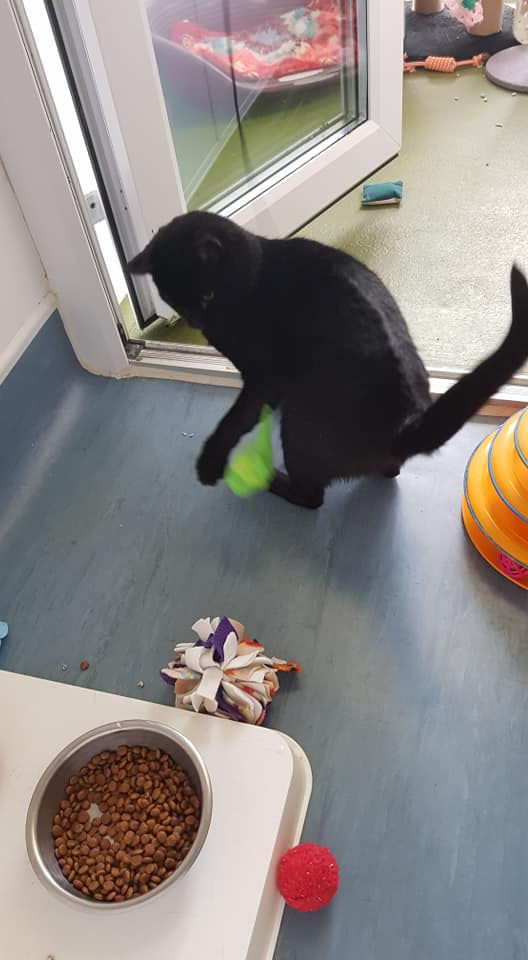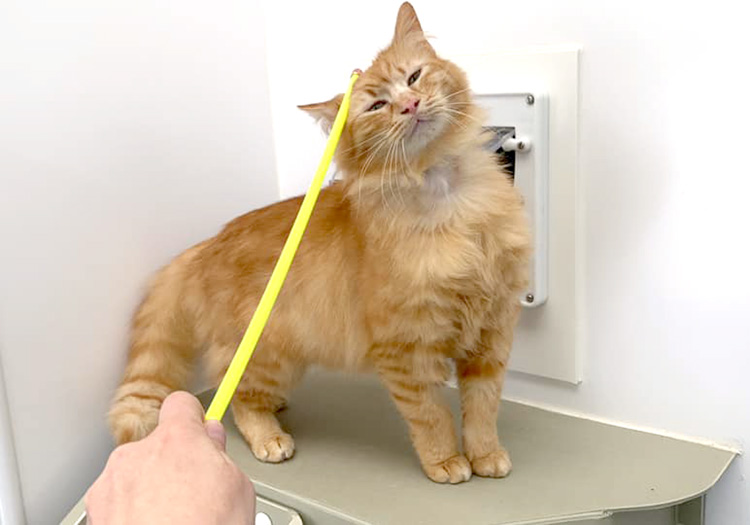This is a guide to some socialisation and befriending a cat that is hiding and wary. Patience and predictability is key, and always move at the cat’s pace. If you go a step too fast, then go back a few steps rather than one as you have broken that trust. This can take a few weeks to a few months, completely depending on the cat.
Each session should be quite short, 5-10 minutes is plenty. Start with sound, then move on to food and/or play, and finally touch.
Working with sound
Talk gently and quietly to nervous cats when you are in their room. At the cattery, we have the radio on, and sometimes just sit in their pod and read the news out loud to them just so they are aware we are about and mean no harm. Avoid maintained eye contact and sit side-on to their hidey hole.
Working with food
1. Sit a couple of metres away with some cooked chicken, tasty cat treats or something you know they LOVE (find what motivates them). Move smoothly, perhaps saying something to alert the cat to your action, and place a treat or two near to the cat and move back again immediately. Your moving away is rewarding for the cat as much as the food.
2. The cat might not eat in front of you at all to start with which means it is very stressed by your presence, but once the cat comes to take the food with you at this distance, start moving your sitting position closer. Your aim is for the cat to associate you with food. This will take time. If you think the cat is ready for it, lie down flat on your tummy instead of retreating and place the food from there. When you are lying down, you are less frightening for the cat.
3. Try to end each session on a good note so move right back if you have to.

Augustus was one of our cats who responded best with play to build confidence
Working with play
Some cats are more motivated by play than food so this could be the way to bond with them.
Start by using wand and teaser toys as these with longer handles help to create distance between you and the cat. Test to find what they prefer, feathers, a fishing rod, string or even the stick of the wand toy can be a favourite. Attempt play first slowly dragging along the ground and then up in the air (without too fast movements as not to scare them more!) as some cats prefer to hunt rodents/ground dwelling prey and some prefer birds and to swot prey from the air – find what your cat likes!
Even if the cat becomes fixated on the toy but doesn’t chase it, that still means the hunting sequence has been initiated and they are interested, so keep going. Cats love to ambush their prey, so try dragging the toy behind something or make it disappear or reappear slowly, in the wild prey wouldn’t be out in the open, so mimic how they would behave in play too.
As they get more into the play bring the cat out in the open more gradually, but don’t try and touch them, stay still and let them sniff you if they come close. Each time they are brave and venture a bit further but nothing bad happens it will reinforce that its safe.
TOP TIP: Rotate toys. Cats get very bored of toys quickly, so keep some toys back and swap them out regularly to keep them interested. Use catnip spray or dried, to keep it extra interesting!

Working with touch
Hands can be very scary to a nervous cat. They may have a history of being hurt, picked up or grabbed at or just never have been touched at all.
1. Pad the other end of a wand toy, sit at a distance and after you’ve let them sniff it all over use this to gently tickle and stroke the head if they’ve initiated it, under the chin or cheeks. Every cat likes to be fussed differently, so find out what your cat enjoys.
2. If your cat is comfortable with this move closer with the wand and then you can try to use a soft brush to fuss instead. Each time, give a couple of brushes and stop to gauge their reaction. If they move away, then the session is over.
3. When your cat is ready to try your hands, offer the back of your hand with closed in fingers. If the cat comes to your hand to push against it, then you can start to explore touching them more. Just give a couple of fusses and stop to gauge their reaction. If they want to stop, then that is the end of the session.
Some cats can be simultaneously very frightened and yet crave human attention. Don’t assume that because they enjoyed a chin tickle that they are no longer nervous. Some slight noise or movement will still spook them.
Watch the video below to see our team work with Bobby in the cattery (from November 2021), and you'll spot many of these techniques.